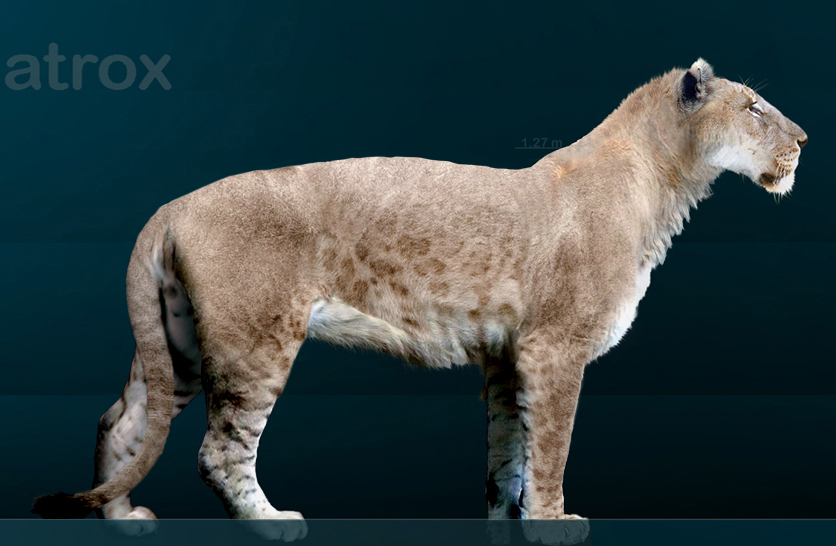Post by Infinity Blade on Nov 22, 2014 21:43:59 GMT 5
American Lion-Panthera leo atrox or Panthera atrox
The American lion (Panthera leo atrox or P. atrox) — also known as the North American lion, Naegele’s giant jaguar or American cave lion — is an extinct lion of the family Felidae, endemic to North America and northwestern South America during the Pleistocene epoch (0.34 million to 11,000 years ago), existing for about 0.33 million years. It has been shown by genetic analysis to be a sister lineage to the Eurasian cave lion (Panthera leo spelaea or P. spelaea). The American lion is one of the largest types of cat ever to have existed, slightly larger than the early Middle Pleistocene primitive cave lion, P. leo fossilis and about 25% larger than the modern African lion. The American lion is an extinct animal that originated in North America and is believed to have colonized northwestern South America as part of the Great American Interchange. (However, the fossil remains found in Peru may actually correspond to large jaguars.) The head-body length of the American lion is estimated to have been 1.6–2.5 m (5 ft 3 in–8 ft 2 in) and it would have stood 1.2 m (4 ft) at the shoulder. Thus, it was smaller than its contemporary competitor for prey, the giant short-faced bear, which was the largest carnivoran of North America at the time. The American lion was not as heavily built as the saber-toothed cat Smilodon populator, which may have weighed up to 360 kg (790 lb). Sorkin (2008) estimated the American lion to weigh roughly 420 kilograms (930 lb), but a more recent study showed an average weight for males of 256 kg (564 lb) and 351 kg (774 lb) for the largest specimen analyzed. Around 100 specimens of American lions have been recovered from the La Brea Tar Pits, in Los Angeles, so their body structure is well known. The features and teeth of the extinct American lion strongly resemble modern lions, but they were considerably larger. The American lion is believed to be the largest subspecies of lion.

© @ serchio25 (Sergio De La Rosa Martínez)
Sarkastodon mongoliensis
Sarkastodon is an extinct genus within the family Oxyaenidae that lived during the upper Eocene, approximately 35 million years ago. It was a large, carnivorous animal that lived in what is today Mongolia. Sarkastodon is known only from a skull and jawbones. Sarkastodon, like creodonts in general, was probably a hypercarnivore that preyed on large mammals in its range during the Late Eocene, such as brontotheres, chalicotheres, and rhinoceroses. Sarkastodon was a hypercarnivore, with hyaena-like dentition specialised in bone-cracking. The sharp, slicing premolars (which form roughly rectilinear cutting blades) and crushing molars enabled Sarkastodon to eat both bone and flesh.

© @ bLAZZE92 (blaze on this forum)
The American lion (Panthera leo atrox or P. atrox) — also known as the North American lion, Naegele’s giant jaguar or American cave lion — is an extinct lion of the family Felidae, endemic to North America and northwestern South America during the Pleistocene epoch (0.34 million to 11,000 years ago), existing for about 0.33 million years. It has been shown by genetic analysis to be a sister lineage to the Eurasian cave lion (Panthera leo spelaea or P. spelaea). The American lion is one of the largest types of cat ever to have existed, slightly larger than the early Middle Pleistocene primitive cave lion, P. leo fossilis and about 25% larger than the modern African lion. The American lion is an extinct animal that originated in North America and is believed to have colonized northwestern South America as part of the Great American Interchange. (However, the fossil remains found in Peru may actually correspond to large jaguars.) The head-body length of the American lion is estimated to have been 1.6–2.5 m (5 ft 3 in–8 ft 2 in) and it would have stood 1.2 m (4 ft) at the shoulder. Thus, it was smaller than its contemporary competitor for prey, the giant short-faced bear, which was the largest carnivoran of North America at the time. The American lion was not as heavily built as the saber-toothed cat Smilodon populator, which may have weighed up to 360 kg (790 lb). Sorkin (2008) estimated the American lion to weigh roughly 420 kilograms (930 lb), but a more recent study showed an average weight for males of 256 kg (564 lb) and 351 kg (774 lb) for the largest specimen analyzed. Around 100 specimens of American lions have been recovered from the La Brea Tar Pits, in Los Angeles, so their body structure is well known. The features and teeth of the extinct American lion strongly resemble modern lions, but they were considerably larger. The American lion is believed to be the largest subspecies of lion.

© @ serchio25 (Sergio De La Rosa Martínez)
Sarkastodon mongoliensis
Sarkastodon is an extinct genus within the family Oxyaenidae that lived during the upper Eocene, approximately 35 million years ago. It was a large, carnivorous animal that lived in what is today Mongolia. Sarkastodon is known only from a skull and jawbones. Sarkastodon, like creodonts in general, was probably a hypercarnivore that preyed on large mammals in its range during the Late Eocene, such as brontotheres, chalicotheres, and rhinoceroses. Sarkastodon was a hypercarnivore, with hyaena-like dentition specialised in bone-cracking. The sharp, slicing premolars (which form roughly rectilinear cutting blades) and crushing molars enabled Sarkastodon to eat both bone and flesh.

© @ bLAZZE92 (blaze on this forum)















